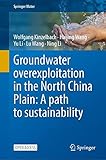Groundwater overexploitation in the North China Plain: A path to sustainability [electronic resource] / by Wolfgang Kinzelbach, Haijing Wang, Yu Li, Lu Wang, Ning Li.
Tipo de material: TextoSeries Springer WaterEditor: Singapore : Springer Nature Singapore : Imprint: Springer, 2022Edición: 1st ed. 2022Descripción: XVIII, 157 páginas98 ilustraciones, 89 ilustraciones in color. online resourceTipo de contenido:
TextoSeries Springer WaterEditor: Singapore : Springer Nature Singapore : Imprint: Springer, 2022Edición: 1st ed. 2022Descripción: XVIII, 157 páginas98 ilustraciones, 89 ilustraciones in color. online resourceTipo de contenido: - texto
- computadora
- recurso en línea
- 9789811658433
- 551.48 23
Chapter 1 Introduction -- Chapter 2 Policy options of over-pumping control in the NCP -- Chapter 3 Cropping choices and farmers' options -- Chapter 4 Decision support for local water authorities in Guantao County -- Chapter 5 Way forward.
Open Access
Over-pumping of aquifers is a worldwide problem, mainly caused by agricultural water use. Among its consequences are the falling dry of streams and wetlands, soil subsidence, die-off of phreatophytic vegetation, saline water intrusion, increased pumping cost and loss of storage needed for drought relief. Stopping or reversing the trend requires management interventions. The North China Plain serves as an example. A management system is set up for a typical county. It contains three components: monitoring, decision support based on modelling, and implementation in the field. Besides all monitoring data, the decision support module contains an irrigation calculator, a box model, and a distributed groundwater model to project the outcomes of different water allocation scenarios. In view of grain security, a solution combines an adaptation of the cropping system with imports of surface water from the South. The Open Access book does not only describe the problem and the path to its solution. It also gives access to nine manuals concerning methods used. They include computer programs and the game Save the Water. The Chinese experience should be of considerable interest to other regions in the world which suffer from over-pumping of aquifers.
No hay comentarios en este titulo.
